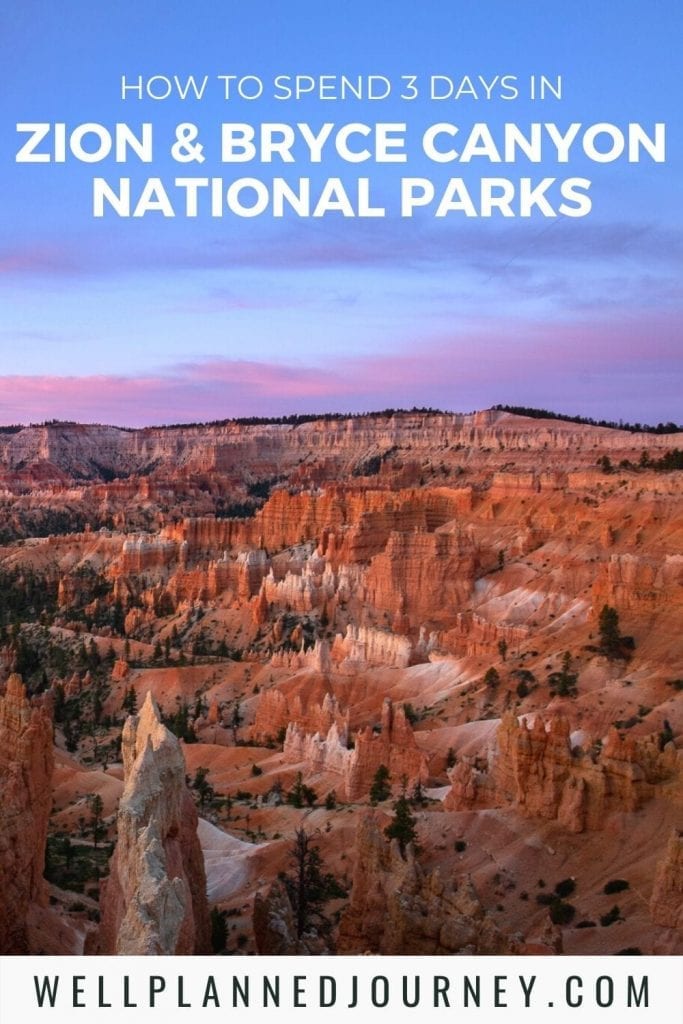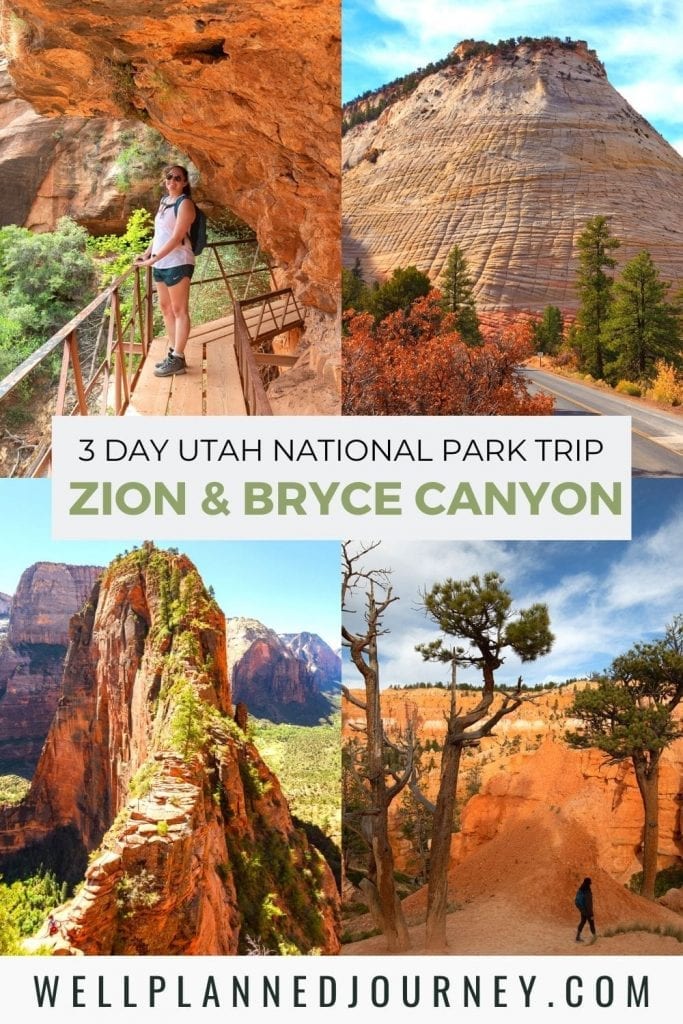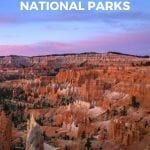Utah is home to beautiful landscapes and once-in-a-lifetime hikes. Those stunning views are best captured in the national parks found here.
The best way to see the highlights of Utah’s national parks is on a 3-day road trip from Zion to Bryce Canyon National Park.
Combining these national parks on a short road trip is the best way to experience the best hikes in Utah and its unique beauty.
This guide on roadtripping from Zion to Bryce Canyon covers:
- Best things to do in both Zion and Bryce Canyon National Parks
- Tips on where to stay near both Zion and Bryce Canyon
- What to pack for your national park adventure
- And the best route for traveling from Zion to Bryce Canyon
This post may contain affiliate links, where I may receive a small commission at no additional cost to you. Read more in this disclosure policy.
Zion National Park At-A-Glance
Before diving in, here are a few highlights to help you plan your trip:
- Best Time to Visit: Spring or Fall are the best times to visit thanks to mild weather, perfect for hiking. Avoid crowds by visiting in March or November, on either end of peak season.
- Where to Stay: If you’re looking to stay in the park, your best option is Zion Lodge. If you’re looking to stay outside the park, I highly recommend either Cliffrose Lodge or Driftwood Lodge in Springdale.
- How to Get There: The closest airports are in Las Vegas (3 hours away) or Salt Lake City (4.5 hours away). Use Expedia to browse flights and find the best price.
- How to Get Around: Zion National Park requires visitors to take the free shuttle from Spring to Fall. However, you’ll still need your own car to get to Zion. Use Expedia to browse deals on rental cars or rent an RV or campervan with Outdoorsy!
- Best Self-Guided Tour: My favorite way to learn more about the park is with GyPSy Guides, a narrated self-guided tour perfect for road trips and scenic drives. The Zion & Bryce Canyon Guide and the Utah “Mighty 5” Bundle both provide incredible commentary and detail about the history and geology of these parks.
- Don’t Forget: Be sure to get an America the Beautiful National Park Pass ahead of time. This $80 pass is valid for 12 months and get you into all 400+ national park sites (including Zion!).
Bryce Canyon At-A-Glance
Before diving in, here are a few highlights to help you plan your trip:
- Best Time to Visit: Spring or Fall are the best times to visit thanks to mild weather, perfect for hiking. Avoid crowds by visiting in March or November, on either end of peak season (just be sure to bundle up as it will be chilly!).
- Where to Stay: If you’re looking to stay in the park, your best option is The Lodge at Bryce Canyon. If you’re looking to stay outside the park, I highly recommend the Best Western Ruby’s Inn in Bryce, Utah (only minutes from the park entrance!).
- How to Get There: The closest airports are in Las Vegas or Salt Lake City, both 4 hours away. Use Expedia to browse flights and find the best price.
- How to Get Around: The easiest way to get around Bryce Canyon is in your own car. Use Expedia to browse deals on rental cars or rent an RV or campervan with Outdoorsy.
- Best Self-Guided Tour: My favorite way to learn more about the park is with GyPSy Guides, a narrated self-guided tour perfect for road trips and scenic drives. The Zion & Bryce Canyon Guide and the Utah “Mighty 5” Bundle both provide incredible commentary and detail about the history and geology of these parks.
- Don’t Forget: Be sure to get an America the Beautiful National Park Pass ahead of time. This $80 pass is valid for 12 months and get you into all 400+ national park sites (including Bryce Canyon!).
Why Visit Zion National Park
Zion National Park was the first national park of Utah’s “Mighty 5”, first established in 1919 (just over 100 years old!). It’s one of the oldest national parks and one of the most popular!
Each year, Zion attracts over 4 million visitors. There has to be a reason for that, right?
Well, I think people flock to Zion for its bucket list-worthy hikes! Some of the most popular national park hikes are found here:
- Angels Landing
- The Narrows
- Observation Point
But even if you aren’t a hiker, Zion National Park has something for you! There are scenic drives, bicycling, canyoneering, and even rock climbing.
Rest assured, you’ll easily be able to fill 2 days in Zion National Park with exciting activities!
Why Visit Bryce Canyon National Park
Bryce Canyon National Park has one of the most unique landscapes in the world. It’s famous for its hoodoos, rock formations formed by erosion. These hoodoos can only be found in a few places around the world!
In fact, Bryce Canyon has the largest concentration of hoodoos in the world! That’s why millions of people come to marvel at them every year.
The park’s main scenic drive provides endless opportunities to spot the famous hoodoos.
Bryce Canyon is also one of the best places in the United States to stargaze and spot the Milky Way!
Where to Stay Near Zion and Bryce Canyon
Both Zion and Bryce Canyon offer a wide variety of accommodations, from camping to resorts. Here are some of my favorite places to stay near both these parks!
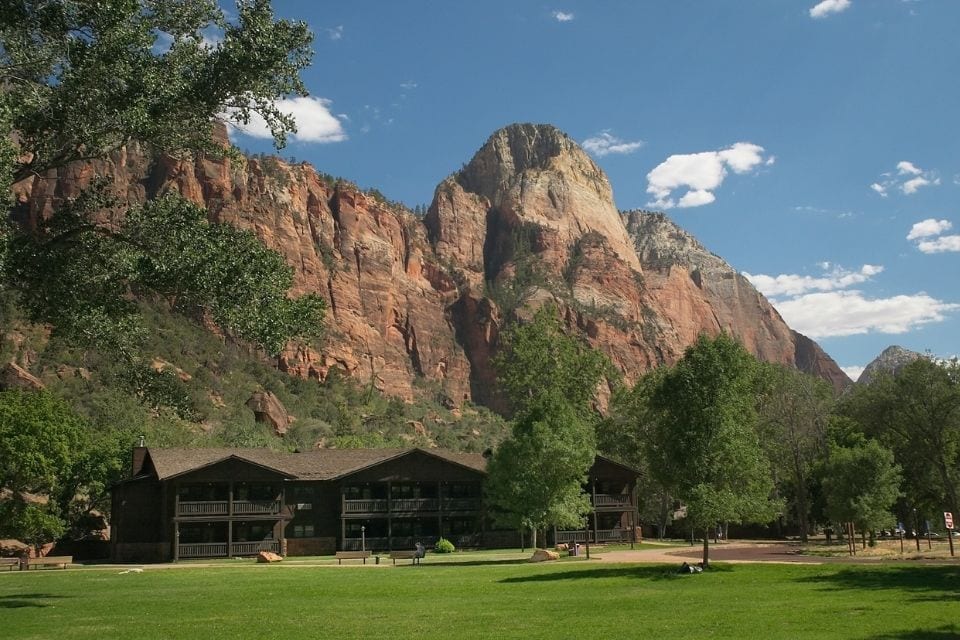
Where to Stay Near Zion National Park
Unlike many national parks, Zion has a decently sized town right next door. Here you can find plenty of hotels or home rentals.
Plan to book hotels in Springdale at least 3 months out.
Inside the park, you’ll find a handful of campgrounds and a lodge. To stay in the park, book 6 months out for campgrounds and a year out for the lodge.
This interactive map can also help you search all the available hotels and rental properties near Zion National Park! Simply scroll and click the map below to see what is available!
Staying in Zion National Park
- Zion Lodge, the only hotel inside the park
- Watchman Campground, reservable 6 months out
- South Campground, reservable 14 days in advance
Hotels Outside Zion National Park
- Cliffrose Lodge, for a more luxurious stay in Springdale
- Driftwood Lodge, for budget travelers in Springdale
Where to Stay Near Bryce Canyon National Park
While not as big as Springdale, the nearby towns of Bryce and Tropic provide some options for accommodations outside the park.
To get a spot just outside the park, be sure to book 3 to 6 months out.
Bryce Canyon’s in-park accommodations are a hot commodity, especially the lodge. Be sure to book as far out in advance as possible (more than 1 year to stay in the lodge).
This interactive map can also help you search all the available hotels and rental properties near Bryce Canyon National Park! Simply scroll and click the map below to see what is available!
Staying in Bryce Canyon National Park
- The Lodge at Bryce Canyon, the only hotel inside the park and the most convenient place to stay
- North Campground, first-come, first-served campground open all year
- Sunset Campground, reservable 6 months out in the summer
Hotels and Campgrounds Outside Bryce Canyon National Park
- Best Western Plus Bryce Canyon Grand Hotel or Best Western Plus Ruby’s Inn, the two Best Western locations just outside the park in Bryce
- Bryce Canyon Inn, a budget motel in Tropic, about 15 minutes from the park
- Ruby Inn’s RV Park and Campground, a budget option for camping or glamping outside the park in Bryce
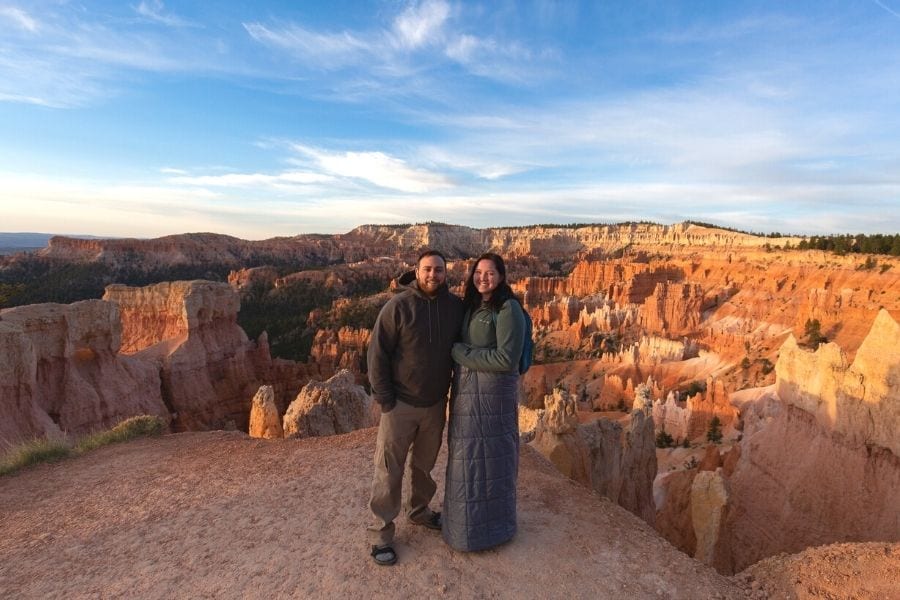
Tips for Visiting Zion National Park and Bryce Canyon National Park
On a short road trip like this one, it’s important to plan ahead to get the most out of your trip.
Here are some important tips to remember when planning your road trip from Zion to Bryce Canyon.
General Tips for Both Parks
- Get the America the Beautiful National Park Pass. This covers your admission to both parks (as well as every other national park) for a full year for only $80. If you don’t go with the national park pass, you’ll need to pay $35 admission at each park. Click here to buy your America the Beautiful Pass now.
- Start your day early. Both Zion and Bryce Canyon are popular national parks with millions of visitors each year. Start your day shortly after sunrise for the best parking options and avoiding crowds.
- Save money by renting a sedan instead of an SUV. I usually prefer to rent a bigger vehicle with all-wheel-drive on national park trips. But that isn’t needed for Zion and Bryce Canyon as all the roads here are paved and easily accessible. You’ll save money by renting a more compact sedan.
- Book your trip well in advance if you want to stay in the park. Campsites fill up when reservations are released on a rolling 6-month basis. If you want to stay in a park lodge, plan to book 13 months out when reservations open.
Are you visiting multiple national parks in the next year? The America the Beautiful National Park Pass gets you into 400+ national park sites, including all 63 national parks, for 12 months!
Get your national park pass ahead of time for only $80.
Zion National Park Tips
- Take the shuttle early in the day. In peak season, all visitors are required to take the park shuttle. After about 10 am, shuttle lines can reach up to an hour. Check the Zion shuttle website for the latest updates.
- Stock up on groceries elsewhere. You’ll save lots of money by grocery shopping before heading to the park, like at the Walmart in St. George.
- Do your hikes in the morning. By starting early and taking one of the first shuttles, you’ll beat the crowds on the trails. This is particularly important for popular hikes like Angels Landing and The Narrows.
- Be prepared for thunderstorms. Summer thunderstorms are common in Utah and can be dangerous for hikers. Always check the weather forecast before hiking, particularly for The Narrows.
Important Note
Zion National Park is requiring all visitors to get an advance permit to hike Angels Landing. You can read more about how to get an Angels Landing permit here.
The main route to Observation Point is closed due to a rockslide in 2019. However, there’s an alternate route to reach the peak, which you can read about in my Observation Point blog post.
Bryce Canyon National Park Tips
- Sunrise is the best time for photography. You’ll be able to capture the hoodoos glowing orange against the pink sky. Plus crowds are few and far between!
- Bring plenty of water. Bryce Canyon National Park has the highest elevation of the Utah national parks. You dehydrate faster at a higher elevation, so make sure to drink more water than you normally would. This is particularly important to avoid altitude sickness.
- Pack layers. Even in the summer, morning temperatures can be in the 30s and 40s, so dress in layers to unzip as the day warms up.
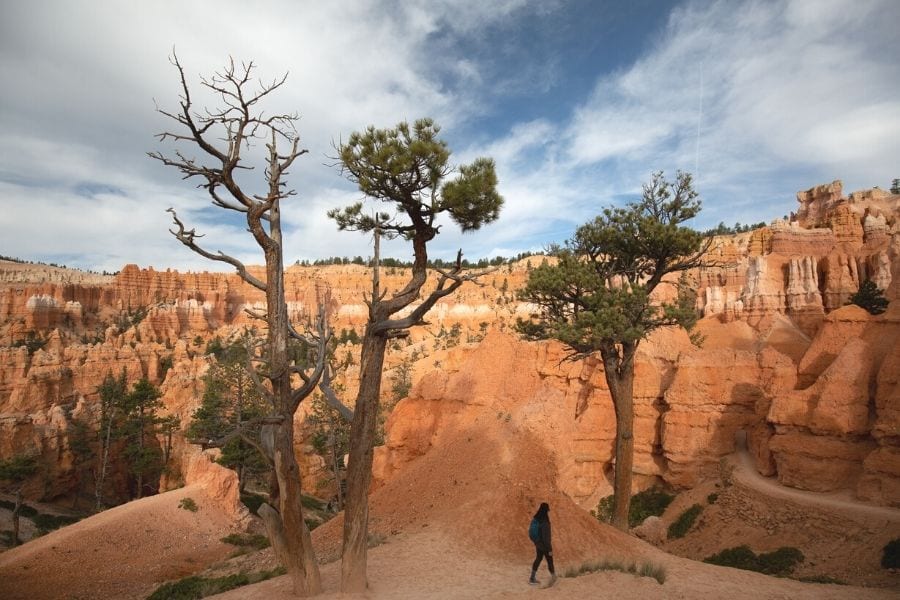
What to Pack for Your Trip to Zion and Bryce
Both Zion and Bryce Canyon can have unpredictable weather, from cold mornings to afternoon thunderstorms. To stay prepared for your trip, be sure to bring these essentials.
- National Park Pass
Zion and Bryce Canyon charge an entry fee to enter the park. If you plan on visiting more than one national park this year, I highly recommend the America the Beautiful National Park Pass. It gets you access to all 60+ national parks and 400+ monuments and sites for 12 months. Get your annual national park pass here for only $80. - Hiking Boots
The best thing to do in these parks is hike. You’ll want sturdy, comfortable hiking boots or trail runners with solid traction. Don’t forget to break in your shoes before your trip! - Merino Wool Socks
Good hiking boots don’t mean anything if you have crappy socks. Always opt for merino wool socks. They might be a bit expensive, but they will last a long time, keep your feet dry, and protect you from blisters. - Hiking Backpack and the 10 Essentials
It’s important to carry safety gear every time you hike, especially if you’re hiking in less busy seasons. Be sure to pack the 10 hiking essentials and bring a hiking backpack with plenty of room for water and extra gear. - Layers
Zion National Park and Bryce Canyon National Park weather can vary dramatically from day to night, particularly in Spring and Fall. While the mornings may start off cool, afternoons can be hot. Pack moisture-wicking hiking shirts and warm fleece layers to keep you comfortable all day. I even brought a blanket as you can see above to stay warm during sunrise. - Rain Jacket
In the summer, thunderstorms can spring up at any time. While it might just be a quick rain, it’s best to be prepared and always carry a rain jacket or poncho. - Camera
You’ll want to capture every view from Zion to Bryce Canyon, but how you do that is up to you. Today, even an iPhone will do. If you choose to travel with a nice camera, I highly recommend investing in a sturdy camera clip to secure your camera to your hiking backpack. - Sun Hat and Sunscreen
Many of Zion and Bryce’s trails are unshaded, so it’s important to protect yourself from the sun. Sunscreen is obviously essential, but a sun hat will go a long way towards protecting you from sunburn too.
Looking for more tips on what to pack for your trip? Check out my guides on the best hiking gear, what to pack for a road trip, and essential camping gear for all my favorite gear picks and tips to make packing for your trip a breeze!
Route: Las Vegas to Zion National Park to Bryce Canyon National Park
For this Utah road trip, I recommend starting in either Salt Lake City or Las Vegas. Which one is best for you will depend on flight prices.
I use Expedia to find the best flight prices and compare routes. Once you find your flight, you can book directly through Expedia to save money, but still enter your frequent flyer numbers to get points!
If you need a rental car, I also recommend using Expedia to find the best deals across brands like Avis, Hertz, Enterprise, Budget, and more.
Zion National Park is roughly 3 hours from Las Vegas and 5 hours from Salt Lake City.
Start your trip in Zion National Park as it’s closer to both Las Vegas and Salt Lake City. After that head to Bryce Canyon National Park!
You can add Utah’s other 3 national parks after visiting Bryce Canyon by continuing north along Highway 12 to Capitol Reef National Park.
Check out the map below for the full road trip route from Zion to Bryce Canyon.
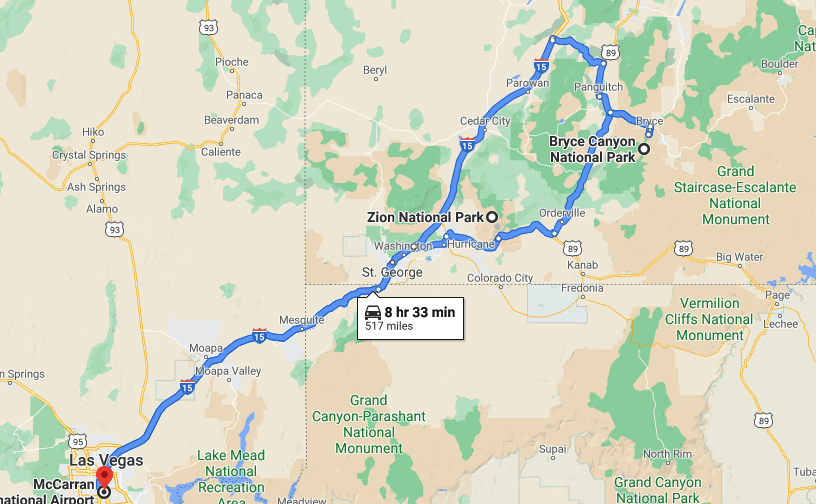

How to Get Around Bryce Canyon to Zion
You’ll need to rent a car at the airport to get to and from both of these parks. In peak season, Zion requires all visitors to take the shuttle into the park to avoid congestion. Bryce Canyon allows visitors to drive throughout the park all year.
Zion National Park Shuttle
The shuttle runs throughout the peak season, from spring to fall. It starts at the visitor center and runs to the end of Zion Canyon Scenic Drive at the Temple of Sinawava.
The shuttle stops at all major trailheads and runs every 10 to 15 minutes.
Because the park requires all visitors to take the shuttle, it can get crowded. On a summer afternoon, you can expect to wait an hour to catch the shuttle at the visitor center.
Try to get one of the first few shuttles into the park (between 6 and 7 am). This will ensure you’re spending your time hiking instead of waiting in line.
If you’re staying in Springdale, you can drive to the visitor center and board the shuttle there.
The town of Springdale also runs a shuttle with 9 stops along the main road through the town if you prefer not to park at the visitor center.
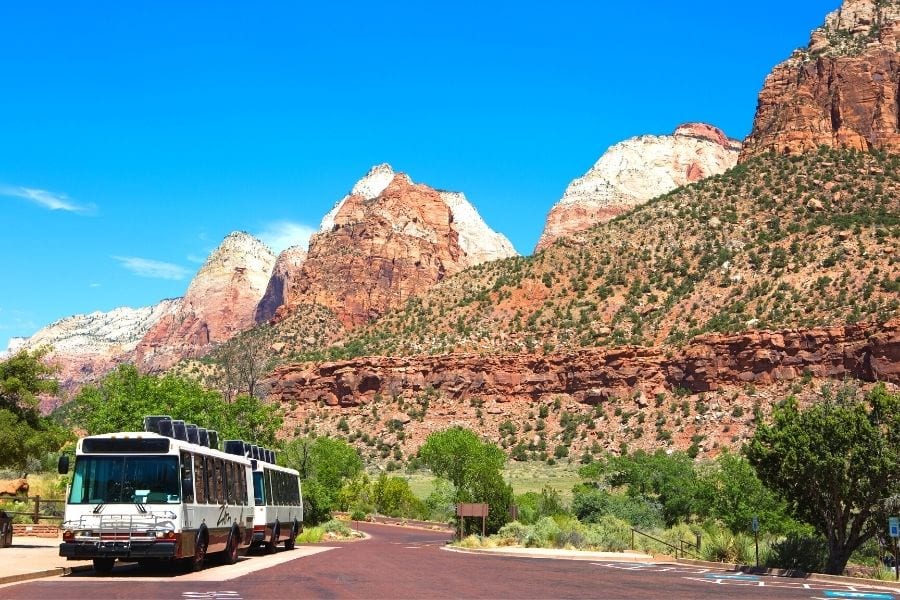
Bryce Canyon National Park Shuttle
While Bryce Canyon also offers a shuttle from April to October, it’s optional. It starts in the town of Bryce and runs throughout the park, stopping at the visitor center and campgrounds.
Instead of taking the shuttle around Bryce Canyon, I recommend driving your own vehicle. Just be aware that parking can be limited, so start your day early to beat the crowds!
Best Time of Year to Visit Zion and Bryce Canyon
Both Zion and Bryce Canyon are open all year long. In fact, many visitors prefer to visit in the winter for a chance to explore without crowds.
But while winter can provide an opportunity to see snow-covered hoodoos, I recommend visiting these parks in the warmer months.
From April to October, the weather is warm, perfect for hiking. But crowds flock to these parks in the summer. To avoid crowds, it’s best to visit in either spring or fall.
The best months in Zion and Bryce Canyon are April, May, September, and October.
For more on the weather and best things to do in each season in Zion, check out my guide on the Best Time to Visit Zion National Park.
Zion to Bryce Canyon National Park Map
Use this map to see exactly where you’ll go on this 3-day road trip in Zion and Bryce Canyon.
3 Day Itinerary from Zion to Bryce Canyon
This road trip from Zion to Bryce Canyon National Park is a 3-day loop. You can start the loop from either Las Vegas or Salt Lake City, depending on where you can find the cheaper flight.
- Day 1: Zion National Park – Hike Angels Landing or Observation Point
- Day 2: Zion + Bryce Canyon – Hike The Narrows and Drive to Bryce
- Day 3: Bryce Canyon National Park – Hike amongst the hoodoos
Important Note
Zion National Park is requiring all visitors to get an advance permit to hike Angels Landing. You can read more about how to get an Angels Landing permit here.
The main route to Observation Point is closed due to a rockslide in 2019. However, there’s an alternate route to reach the peak, which you can read about in my Observation Point blog post.
If you have some more time, consider adding the rest of the Utah “Mighty 5” national parks for one epic Utah road trip.
I recommend flying in the previous day and driving to Zion National Park the night before to fully take advantage of your time in Zion!
Don’t miss the best of Utah’s national parks on your upcoming trip! This free, printable Utah national park road trip itinerary covers all the best points of interest in all 5 Utah parks, plus bonus tips on where to stay and side trips to nearby state parks and monuments.
Download your free Utah road trip itinerary here.
Zion National Park Itinerary: Day One
For your first day in Zion National Park, start early. I mean really early – the first shuttles usually start running before 7 am! To avoid lines for taking the shuttle into the park, plan to take one of the first shuttles of the day.
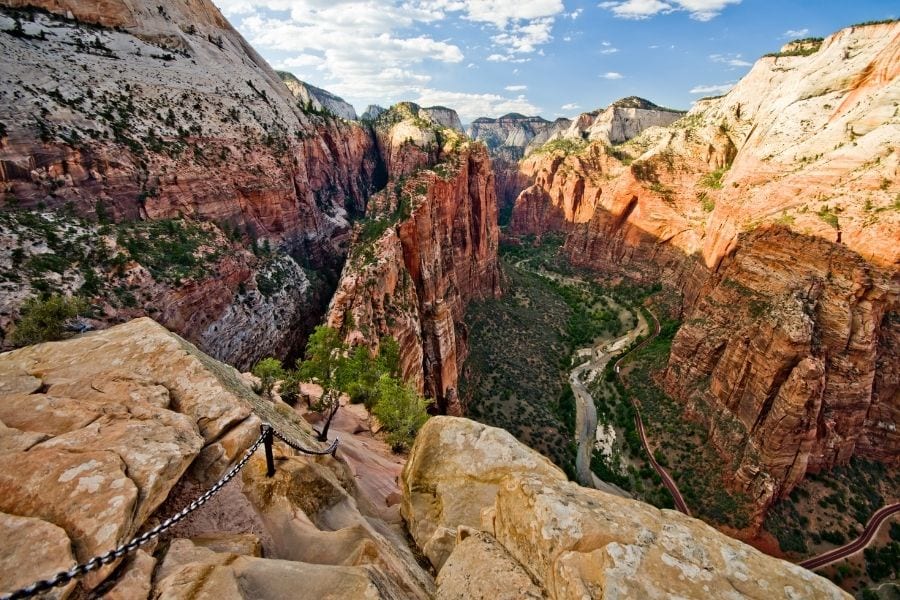
Angels Landing
Your first adventure in Zion is hiking one of Zion’s most popular trails, Angels Landing! This trail is one of the most popular in the park, especially amongst thrill-seekers.
Angels Landing is not for the faint of heart (or those with a fear of heights). You’ll hike along 1,200-foot drop-offs while gripping a chain bolted into the rock.
You’ll start the hike at the trailhead across the road from The Grotto shuttle stop. The hike to the summit of Angels Landing includes steep switchbacks and climbing along a narrow ridge.
After climbing nearly 1,500 feet of elevation in 2.7 miles, you’ll reach the Angel Landing Summit. You’ll be rewarded with 360-degree views of Zion Canyon.
Plan for this hike to take you around 4 hours.
A great alternative to Angels Landing is Observation Point. The views are great and it’s a safer hike.
Important Note
The main route to Observation Point is closed due to a rockslide in 2019. However, there’s an alternate route to reach the peak, which you can read about in my Observation Point blog post.
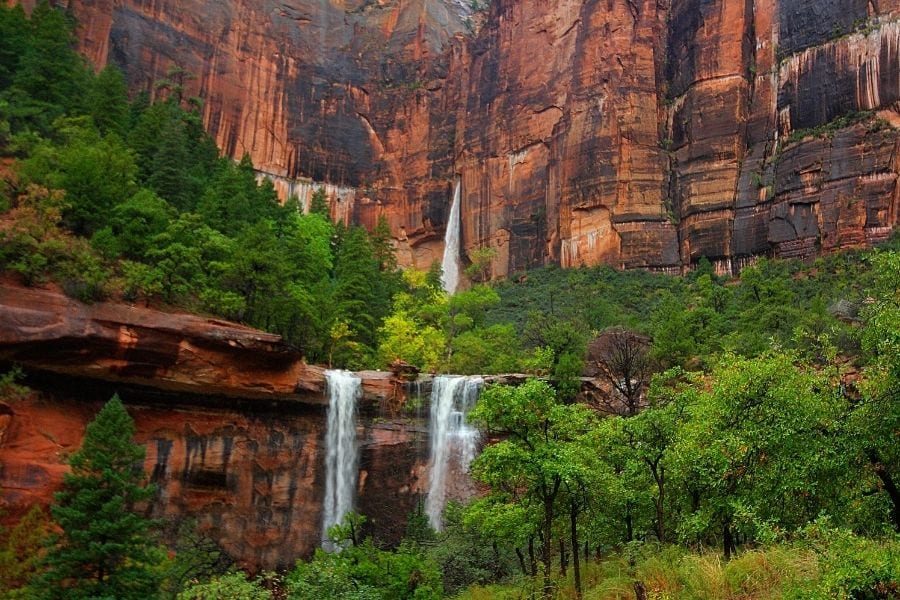
Hike Lower Emerald Pool
After a strenuous hike to Angels Landing, the 1.2-mile trip to Lower Emerald Pool will feel like a piece of cake!
Take the shuttle from The Grotto to Zion Lodge, only one stop away. You can stop at Zion Lodge for a quick bite to eat or pack a picnic lunch.
The trail to Lower Emerald Pool starts across the street from Zion Lodge and follows a paved trail to one of the only waterfalls in Zion.
This relaxing hike is the perfect recovery after hiking Angels Landing and is great for families!
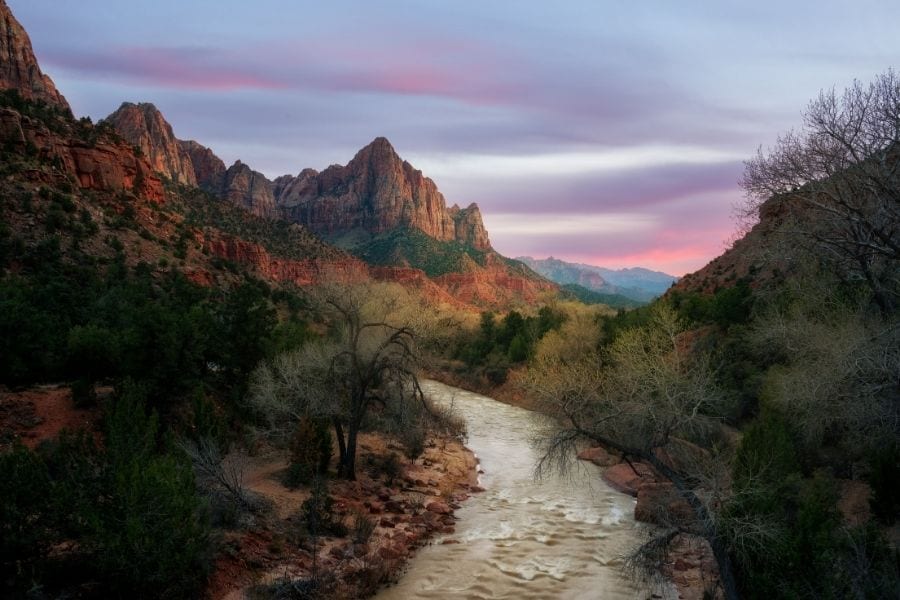
Sunset at Canyon Junction Bridge
End your first day in Zion National Park with sunset views of The Watchman from Canyon Junction Bridge.
The last shuttle out of the park is around 7 pm in spring and fall. To enjoy the sunset and take your time, I recommend taking the shuttle all the way back to the visitor center and picking up your car.
You can drive your car to Canyon Junction (the last spot in the park before the shuttle is mandatory).
Plan to arrive about 45 minutes to 1 hour before sunset to make sure you can find a parking spot.
The view from Canyon Junction Bridge overlooks the Virgin River and The Watchman, a rock formation overlooking Zion.
Head-ups, this is a popular spot amongst photographers, so plan to scope out your perfect vantage point early.
After sunset, grab a bite to eat in Springdale or cook your own campsite meal.
Zion and Bryce Canyon Itinerary: Day Two
On your second and last day in Zion National Park, you’ll spend a half-day exploring The Narrows before driving to Bryce Canyon.
Before heading out to hike The Narrows, check out of your hotel and pack up the car to head to Bryce.

The Narrows
This is truly a bucket list hike because it’s really not a hike at all! The Narrows is a “hike” wading through the Virgin River within a slot canyon!
The Narrows starts at the Temple of Sinawava, the end of the line for the Zion shuttle. Start your day early again to enjoy The Narrows at a leisurely pace.
While the official hike is 9 miles, most visitors choose to simply wade as far as they want upstream before turning back. I recommend hiking at least a mile or two to get the full experience.
Because you’ll spend hours in the water, you’ll need waterproof gear. If you’re hiking The Narrows in the summer when the weather is hot, plan to hike in shorts and waterproof shoes, like Chacos.
If you’re hiking The Narrows before July or after September, plan to rent boots and waders from Zion Outfitter.
A walking stick is essential for your trek up The Narrows. It will stabilize you in the water and make the hike easier.
In the summer, Zion is prone to thunderstorms, which can pose a huge risk for those hiking The Narrows. Thunderstorms can cause flash floods and rapidly rising water levels.
Always check the weather forecast and trail conditions before taking on this hike.
The Narrows is closed to hikers in spring due to high water levels. If you’re visiting Zion in the spring, consider hiking Observation Point on Day 2 instead.
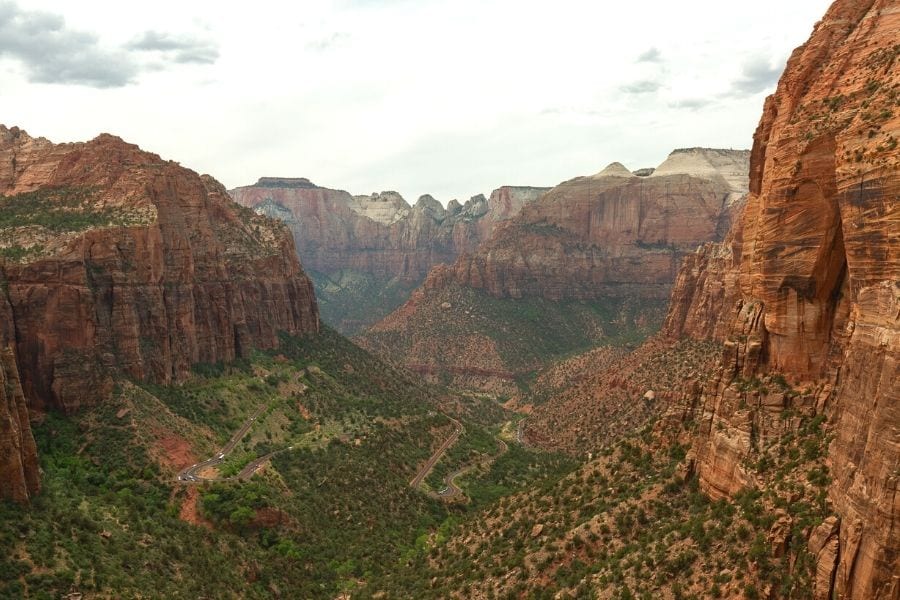
Drive Zion-Mt. Carmel Scenic Highway
After exploring The Narrows, take the shuttle all the way back to the visitor center to grab your car. It’s time for your last hike in Zion!
From Canyon Junction, you’ll climb steep switchbacks up to the historic Zion-Mt. Carmel Tunnel. Just after exiting the tunnel, you’ll find the trailhead to your final adventure in Zion, the Canyon Overlook trail.

Hike Canyon Overlook
The moderate 1-mile Canyon Overlook Trail is located along the Zion-Mt. Carmel Scenic Highway, just after the tunnel. You’ll climb plenty of steps before walking atop a slot canyon. The trail ends at the viewpoint of Zion Canyon.
Enjoy your final view of Zion National Park before heading back to the car and continuing along the scenic drive to Bryce Canyon.
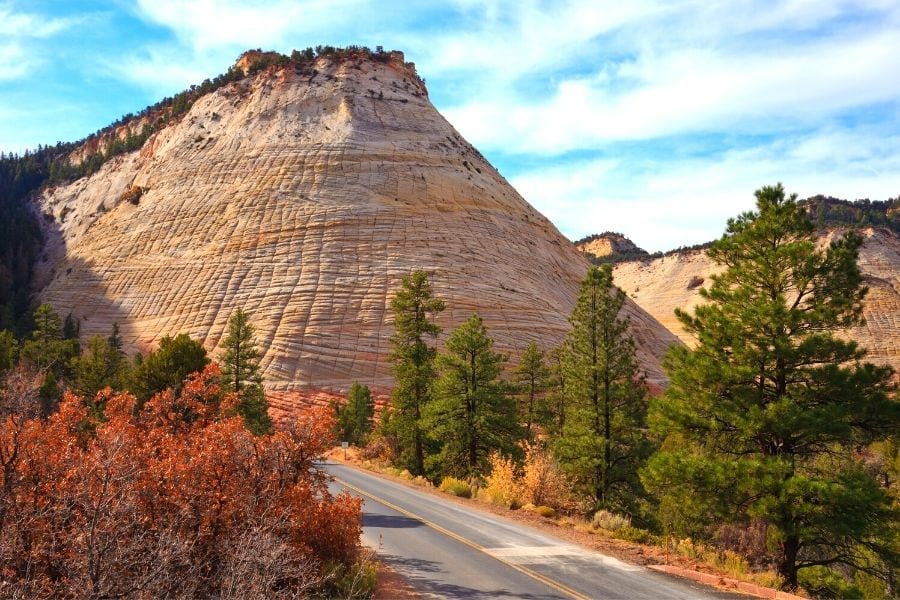
Drive to Bryce Canyon National Park
The scenic drive along Zion Mt. Carmel Highway continues past more red rocks and Checkerboard Mesa, a rock formation formed by erosion, shown above.
The drive to Bryce Canyon takes just under 2 hours. Over the drive, you’ll climb nearly 4,000 feet, so be sure to drink plenty of water to avoid altitude sickness.
Just before reaching Bryce Canyon, you’ll pass Red Canyon. This is the perfect spot to get out, explore, and stretch your legs.
End your day by settling into your accommodation in Bryce Canyon.
Don’t miss the best of Utah’s national parks on your upcoming trip! This free, printable Utah national park road trip itinerary covers all the best points of interest in all 5 Utah parks, plus bonus tips on where to stay and side trips to nearby state parks and monuments.
Download your free Utah road trip itinerary here.
Bryce Canyon National Park Itinerary: Day Three
Your final day will be spent exploring Bryce Canyon National Park, starting before sun-up. Prepare for an epic day by getting a good night’s sleep and setting an early alarm.
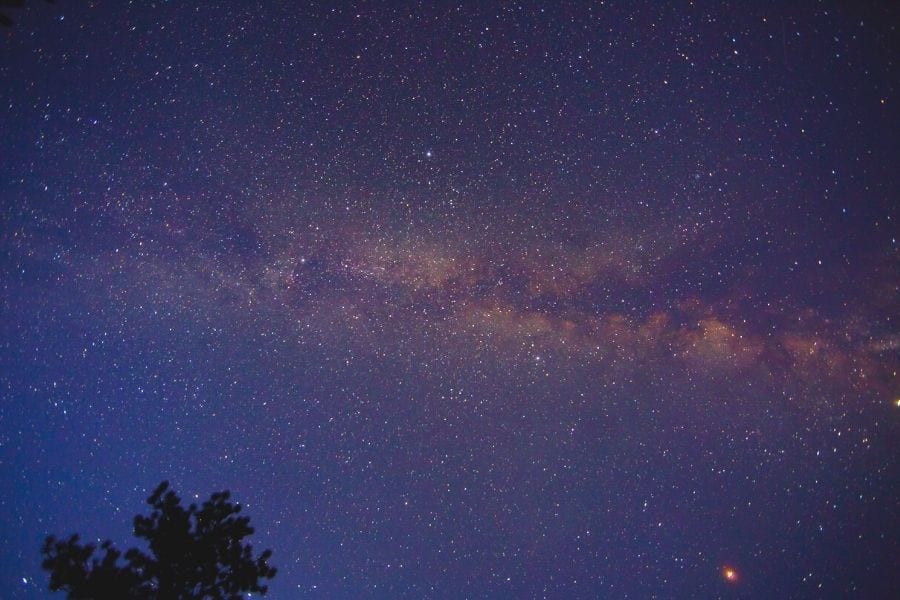
Stargaze in Bryce Canyon
Bryce Canyon National Park is one of the best places in the United States to spot stars, including the Milky Way! As a certified international dark sky park, you’ll be able to see infinite stars scattered across the sky.
On my trip to Bryce Canyon, I was able to spot the Milky Way with my naked eye!
The best time to stargaze in Bryce Canyon will differ on both the time of year and the moon cycle that month.
For best visibility, look for times of the month when the moon is set overnight (meaning not in the sky) or during a new moon. In case you aren’t aware, the moon rises and sets just like the sun!
I like to use Timeanddate.com to check moon cycles and sunrise times for my trip. I also use the charts from Cleardarksky.com for information on daily cloud cover.
Plan to wake up about 1.5 hours before sunrise to stargaze before sticking around to watch the sunrise. It will be cold, even in the summer, so bundle up!
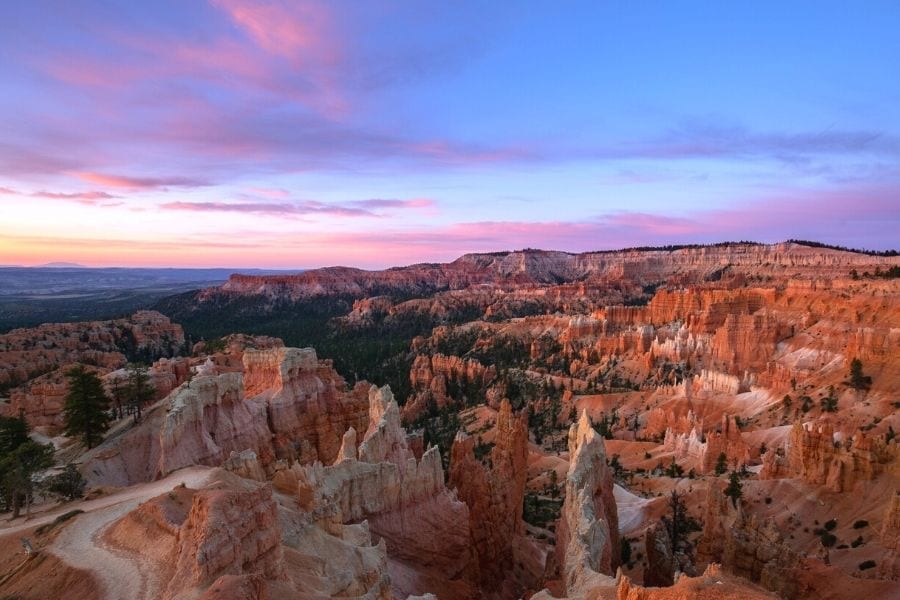
See Sunrise Over Bryce Amphitheater
After stargazing, head over to Sunrise Point and wait for sunrise. The sun creeps over a distant mountain to illuminate the hoodoo-filled amphitheater.
I think this is one of my favorite sunrises I’ve seen. The oranges, pinks, and purples that fill the sky are unbelievable.
After sunrise, stroll along the paved path between Sunrise and Sunset points, stop into the Lodge to warm up, or head out on your first hike of the day.
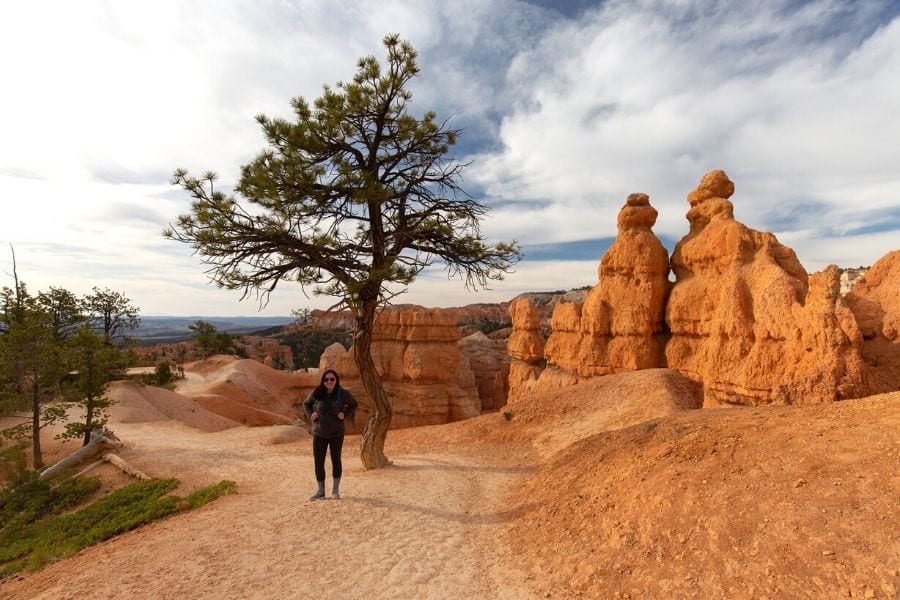
Hike Queen’s Garden / Navajo Loop Trail
The loop through Queen’s Garden and the Navajo Trail is the perfect way to get up close and personal with Bryce Canyon’s signature hoodoos.
This easy to moderate 2.9-mile hike takes you down into Bryce Amphitheater, rather than simply viewing it from above.
Start at Sunrise Point, the same spot you watched the sunrise. You’ll follow the Queen’s Garden trail down into the canyon before following the trail to join the Navajo Loop.
Continue clockwise past landmarks, like the Queen Victoria hoodoo, until you reach Wall Street. This deep slot canyon is a popular photo spot towards the end of the Navajo Loop.
Read More: 12 Best Bryce Canyon National Park Hikes
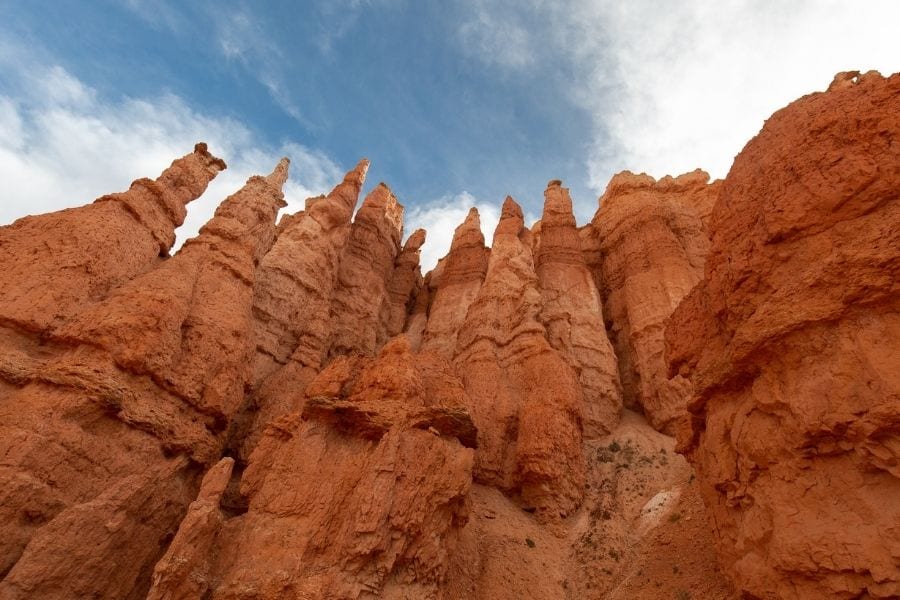
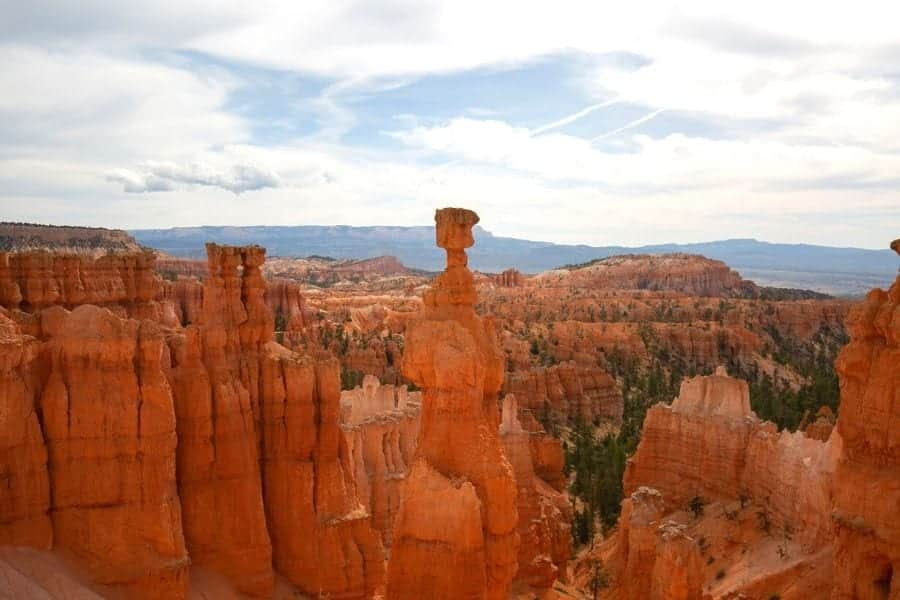
The final climb out of the canyon is the hardest, up steep switchbacks. But at the top of the switchbacks, you’ll be rewarded with jaw-dropping views of the hoodoos, including the popular hoodoo: Thor’s Hammer, shown above.

Drive to 15 Scenic Viewpoints
One of the best and most accessible ways to see Bryce Canyon is on a scenic drive. The park has one main road, starting at the entrance station and running up to the highest point, Rainbow Point.
The drive is 18 miles each way and takes about 3 hours to drive. You’ll gain over 1,200 feet, reaching 9,115 feet at Rainbow Point.
Along the scenic drive, you’ll pass 15 scenic overlooks along Bryce Amphitheater. My favorites are Rainbow Point, Bryce Point, and Inspiration Point, but all 15 are worth stopping at.
You’ll see each of these marked on the official park map here.
I recommend driving all the way to Rainbow Point first. That way, all the viewpoints are on your right-hand side as you head back down, making for easier driving.
You’ll start at Rainbow Point and work your way all the way back down to Fairyland Point.
After your scenic drive, be sure to stop in at both the Lodge at Bryce Canyon and the Visitor Center if you haven’t already.
Returning Home After Exploring Bryce Canyon National Park
At the end of your day in Bryce Canyon National Park, it is time to head home. From Bryce Canyon, it’s 4 hours to both Salt Lake City and Las Vegas airport.
If you’re looking for more Utah adventures, consider these side trips:
- Road trip to all 5 Utah national parks
- Explore Grand Staircase-Escalante National Monument
- Day trip to Capitol Reef National Park
- Explore the drive from Grand Canyon to Bryce Canyon
- Explore Antelope Canyon in Page, Arizona
Read More: 15 Best Things to Do in Capitol Reef National Park
If You Have Extra Time on Your Trip From Bryce to Zion
If you have more than 2 days to spend in Zion National Park, I highly recommend adding on some of these other awesome hikes:
Weeping Rock, Hidden Canyon, and Observation Point can be hiked together since they all start from the same trailhead.
Note: The trails to Weeping Rock, Hidden Canyon, and Observation Point are currently closed due to a massive rockfall. Check the Zion National Park trail status webpage for the latest updates.
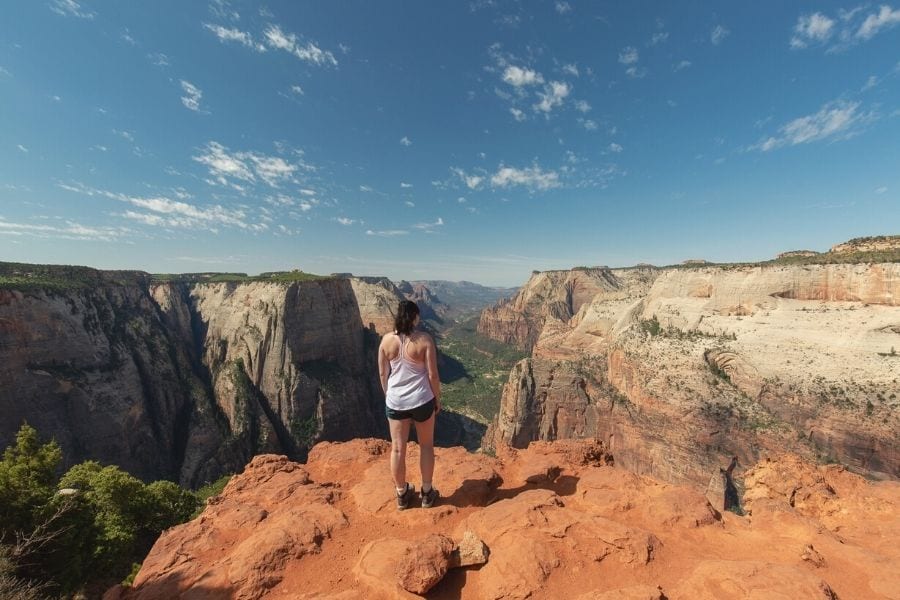
If you have extra time in Bryce Canyon National Park, explore more of the park on other popular trails like:
On a day trip from Bryce Canyon, hike some of the most popular trails in nearby Escalante, including Lower Calf Creek Falls and Spooky Slot Canyon.
Read More: 12 Best Hikes in Bryce Canyon National Park
Frequently Asked Questions about Zion and Bryce Canyon
Can you do Zion and Bryce in one day?
It’s possible to visit both Zion and Bryce Canyon in one day since the parks are only about 1.5 hours apart. However, I recommend taking a 3-day road trip to the 2 parks instead.
Which is better, Zion or Bryce Canyon?
Both Zion and Bryce Canyon are beautiful and fun national parks to explore. If you’re more interested in hiking and thrill-seeking, you’ll enjoy Zion more. If you’re interested in stargazing, photography, and drive-up viewpoints, you’ll enjoy Bryce Canyon more.
Should I spend more time in Zion or Bryce?
If you are more interested in hiking, plan to spend more time in Zion National Park. I recommend at least 2 days. If you’re more interested in scenic drives and accessible, paved trails, I recommend spending more time in Bryce Canyon National Park.
How many days do you need in Bryce Canyon?
You can see the highlights of Bryce Canyon National Park in one day. To experience more of the park and explore nearby Escalante, I recommend spending three days in Bryce Canyon National Park.
How far is Zion from Las Vegas?
Zion National Park is about 170 miles from Las Vegas. The drive is just under 3 hours and changes time zones when crossing the Nevada-Utah state line. If you’re looking for a side trip, don’t miss exploring Valley of Fire State Park along the way.
How far are Zion and Bryce Canyon from each other?
The drive along Highway 12 and Highway 89 from Zion to Bryce Canyon is roughly 85 miles. The scenic drive between the two parks makes for an excellent road trip!
How long of a drive from Zion to Bryce Canyon?
The drive from Zion National Park in Bryce Canyon National Park is about 85 miles and just under 2 hours. Don’t miss scenic stops along the way like Checkerboard Mesa and Red Canyon.
Is Bryce Canyon as busy as Zion?
Bryce Canyon isn’t nearly as busy as Zion. Each year, Zion National Park gets roughly 3 times more visitors than Bryce Canyon National Park. To avoid crowds, spend more time in Bryce Canyon than Zion.
Final Thoughts for Your Road Trip from Zion to Bryce Canyon
Over 3 days, you’ll see the best of Utah’s most popular national parks: Zion and Bryce Canyon.
Don’t forget to pack plenty of layers and book your accommodations well in advance!
Here’s a quick recap of what you’ll do each day:
- Day 1: Zion National Park. You’ll hike Angels Landing and Lower Emerald Pools before checking out Canyon Junction Bridge for sunset.
- Day 2: Zion & Bryce Canyon. You’ll hike The Narrows and Canyon Overlook before heading to Bryce Canyon on the scenic Zion-Mt. Carmel Highway.
- Day 3: Bryce Canyon National Park. You’ll stargaze and see sunrise at Sunrise Point before hiking the Queen’s Garden/Navajo Loop and taking a scenic drive around the park.
Looking for more tips to plan your Utah road trip? Check out these posts!
- Utah Road Trip: 8-Day Utah National Parks Itinerary
- Add Grand Canyon: Zion & Grand Canyon Road Trip Itinerary
- When to Visit: Best Time to Visit Zion National Park
- Hiking in Zion: Hiking the Observation Point Trail in Zion
- Hiking in Bryce: 12 Best Bryce Canyon Hikes
- All Utah Parks: 14 Best National Parks in Utah
Don’t miss the best of Utah’s national parks on your upcoming trip! This free, printable Utah national park road trip itinerary covers all the best points of interest in all 5 Utah parks, plus bonus tips on where to stay and side trips to nearby state parks and monuments.
Download your free Utah road trip itinerary here.
Don’t Forget to Save This Post on Pinterest
